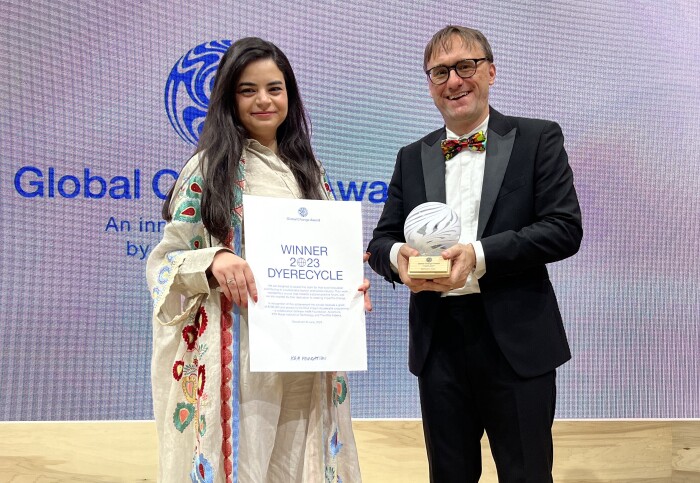DyeRecycle wins vote of confidence from the fashion industry
by Ian Mundell

Dr Aida Rafat and Professor Jason Hallett with their Global Challenge Award.
Securing an H&M Foundation Global Change Award will connect an Imperial startup with high-profile textile manufacturers and fashion brands.
The fashion industry is under pressure to improve its environmental performance, from reducing the waste generated by fast fashion to cutting carbon emissions and eliminating water pollution. Imperial startup DyeRecycle is here to help, with a dye recycling technology that cuts water use, reduces the chance of water pollution and builds recycling. The transformative potential of its approach was recognised this month with a Global Change Award from the H&M Foundation.
“Getting this award, which is considered the Nobel Prize of fashion, is evidence of a significant pull from the industry towards not only fibre circularity, but also chemical circularity,” says Dr Aida Rafat, co-founder and Chief Executive of DyeRecycle.
As far as we know, no-one has ever recycled dyes, and it is such a unique solution for the fashion industry. Professor Jason Hallett Department of Chemical Engineering
Conventional methods of fabric dyeing use immense amounts of water and risk the release of toxic chemicals, the dyes, into the environment. Beginning with the idea that these dyes could be recovered from waste textiles and reused, DyeRecycle has developed an approach to dyeing that does away with water entirely.
The process, developed by Dr Rafat and Professor Jason Hallett in the Department of Chemical Engineering, uses ionic liquids to remove the dyes from waste textiles and transfer them to new fabrics, creating the first circular dyeing process. The waste textile emerges from the procedure white, which makes it much easier to recycle.
“As far as we know, no-one has ever recycled dyes, and it is such a unique solution when the fashion industry is under so much pressure to become more sustainable,” says Professor Hallett, who is DyeRecycle’s Chief Scientific Officer.
An entrée to the fashion world
The Global Change Award is given by the H&M Foundation, the charitable arm of the eponymous global clothing company. The aim is to provide the tools, connections, and resources necessary for early-stage innovations to scale-up as quickly as possible. The ten winners receive €200,000 each and a place on the year-long GCA Impact Accelerator programme.

The money helps, of course, but the real prize is the accelerator, which will bring DyeRecycle into contact with a large number of fashion industry companies, investors and potential partners.
“Getting those links into the fashion industry is invaluable for us,” says Professor Hallett. “We need to meet textiles companies and fashion brands that are interested in sustainability in order to push our product out into the market.”
“It started as an experiment and a concept, and now it is exciting to watch DyeRecycle products making their way into the hands of brands and testing partners,” says Dr Rafat. “Through the support of the H&M Foundation, we will be to accelerate their development and scale-up.”
Reclaiming colour
DyeRecycle’s method results in a colour bath charged with recovered dye, which is then used to treat new fabrics. This means that the colour matching required in the dyeing process is not down to the formulation of the dye, but the selection of waste fabrics.
It started as an experiment. Now it's exciting to watch DyeRecycle products making their way into the hands of brands. Dr Aida Rafat DyeRecycle
Waste that comes directly from clothing manufacturers, either as offcuts or unsold garments, is the easiest to work with, since it arrives in batches of the same fabric and colour. This is where partnerships with the industry will be essential.
However, the process can also work with old clothes, as long as they are sorted first. “We are capable of doing colour matching no matter what we use as an input,” Professor Hallett says.
Although DyeRecycle’s process involves a move away from water-based dyeing, the aim is to fit in with existing installations. “We don’t want to be disruptive in terms of equipment. Rather than having to launch a new process, we can just take over an existing dye house and, with a few modifications, run it as it is,” he adds.
Rolling out the cloth
DyeRecycle is presently working in the Department of Chemical Engineering, where it is carrying out bench-scale trials. “But we are about to close our seed funding round, and after that we will be able to conduct more product-market fit and pilot tests with different supply chain partners,” says Dr Rafat.

This will allow it to graduate from dyeing a couple of metres of fabric to entire rolls, enough to turn into garments. “We are starting to launch some pilot projects with different brands, where they give us some of their waste and we transfer the dyes to a piece of white fabric, to show them what we can do.”
These brands will want to test the performance of the recycled dyes, and check for colour fastness and vibrancy, but there are unlikely to be any surprises. “This is a new dying process, but not a new dye,” says Professor Hallett. “The dyes we are using are literally the same dyes that are in the industry right now.”
The goal is to produce a small-scale fashion collection in 2024 or 2025, in collaboration with an adventurous, high-end brand.
Article text (excluding photos or graphics) © Imperial College London.
Photos and graphics subject to third party copyright used with permission or © Imperial College London.
Reporter
Ian Mundell
Enterprise